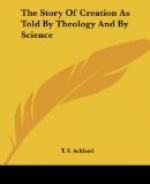The first of these is the impatience of doubt and uncertainty. The power of recognizing the imperfection of our knowledge, and the consequent necessity of suspending our judgment, is a power which is only gradually acquired with the accumulation of experience. The young untrained mind finds it difficult to realize the truth that any information communicated to it is not altogether within the grasp of its faculties. It must attach some definite meaning to the words; it must image to itself some way in which great events were brought about, great works were accomplished. It finds it difficult to realize a fact as accomplished, unless it can also picture to itself some way in which it might have been effected. For this purpose such knowledge as it has at its command is employed, and where that fails recourse is had to the imagination to supply the deficiency. Thus it has been with ourselves in our childhood, and thus it was in the childhood of the world. Knowledge was indeed sought, but it was not sought in the right way, and so the search often resulted in error, and this error produced its effect in the interpretation of the passage in question. The old school of inquirers started from certain abstract principles, and endeavoared to reduce the results of observation to conformity with those principles. This was the case with astronomy. The old astronomers taking as axioms the two assumptions that everything connected with the heavenly bodies must be perfect, and that the circle is the only perfect figure, easily satisfied themselves that the orbits of all the heavenly bodies must be circles. Hence came the
“Cycle on epicycle, orb on orb,”
by which they sought to account for the phenomena which they observed. When once the method was changed, when once it had occurred to Kepler that, as it seemed to be impossible to account for the apparent motion of Mars by any theory of circular orbits, it might be worth while to try to ascertain by observation what its orbit really was, a few years of patient labour sufficed to solve the problem.
It was science such as this, then, that our forefathers brought to the interpretation of the Mosaic Record, and the consequence was that when, from time to time, facts were casually brought to light which might have led the way to vast discoveries, their true significance was never discerned; all that was sought from them was some additional support to the old views. Thus sometimes gigantic bones were exhumed: without investigation, it was at once assumed that they were human bones, and they were brought forward to prove the truth of the statement, “There were also giants in the earth in those days.” Sea-shells were found on mountain sides, far from and high above the sea—they were evidences of the Deluge.




